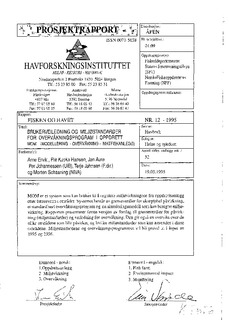| dc.description.abstract | MOM (Monitoring-Ongrowing fish farms-Modelling) is a management system which can relate
the environmental impact from fish farms to the holding capacity of a site. The holding capacity
is defined as the sediments ability to receive organic effluents without causing the benthic impact
to exceed predefined levels. The system consists of three integrated parts: 1) environmental
quality standards, 2) a standardized monitoring program for checking the environmental
conditions on a site according to environmental quality standards, and 3) a mathematical model
for predicting the expected environmental impact in relation to farm specifications and
infonnations on the hydrography and topography of the site. MOM is described in the ICES
report (C.M 1994/F:26): "Case histories and new approaches to planning and modelling in
Norwegian mariculture" (Ervik and Kupka Hansen, 1994). The present report is a first version
of the monitoring program and the environmental quality standards. A revised version will be
published at the end of 1995.
We operate with three degrees of exploitation of a site, relating the benthic impact of the farm
to the holding capacity of the site. A standard monitoring program consisting of three types of
investigations (A, B and C) is carried out for each degree of exploitation, but the heavier the site
is exploited the more frequent the investigations. The boundaries between the three degrees of
exploitation are defined in relation to a group of benthic environmental quality standards.
The A-investigation is a simple sedimentation measurement to inform the fish farmer of possible
excess feeding. The investigation can be performed frequently and by the farmers themselves.NORSK SAMMENDRAG:Rapporten beskriver et overvåkningsprogram for fiskeoppdrett som er en del av et system til å
regulere miljøvirkninger fra marine oppdrettsanlegg etter bæreevnen i området (MOM). Systemet
er beskrevet i Rapport nr 23, 1993, Havforskningsinstituttet, Senter for havbruk, og består av tre
integrerte deler: 1) grenseverdier for miljøvirkning (miljøstandarder), 2) et standardisert
overvåkingsprogram som kan kontrollere miljøtilstand i forhold til miljøstandardene, og 3) en
matematisk modell som kan beregne forventet påvirkning når nødvendige opplysninger om
anlegg og lokalitet er gitt. Overvåkingsprogrammet består av tre typer undersøkelser: A, B og
C. A-undersøkelsen er en enkel undersøkelse av det partikulære utslipp fra anlegget, og kan
foretas av oppdretteren selv. B-undersøkelsen er en kartlegging av sedimentets tilstand under
anlegget (nærsonen) gjennom en undersøkelse av en rekke sedimentvariabler. Disse gis poeng
og vurderes samlet ved hjelp av skjema og diagram for å angi sedimentets tilstand. Denne kan
ligge i en av fire kategorier: 1,2,3 eller uakseptabel, hvor skillet mellom kategoriene defineres
i forhold til et sett av miljøstandarder. C-undersøkelsene er en faunaundersøkelse ved og utover
fra anlegget, og en miljøstandard for akseptable fauna forhold foreslås. | en |
